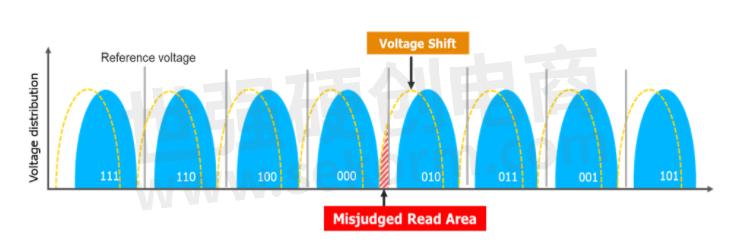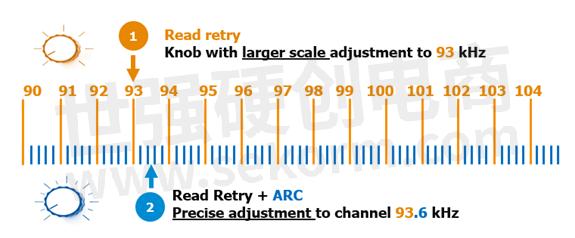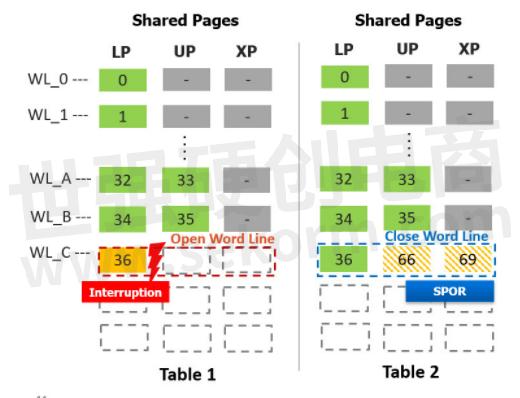Ensuring NAND Flash and Data Integrity of Dashcam Memory Cards (Part 2)




As mentioned in Part 1 Endurance, Latency, and Workload Considerations for Choosing Dashcam Memory Cards, many user behaviours may cause NAND storage failure, such as long-term recording, environmental conditions, or power supply instability. We present the three most frequent causes of data corruption, their fixes, and an enhanced analysis approach based on NAND technology and user behaviours:
Issue 1: NAND Flash Voltage Shifts
Flash may wear out as recording time increases and other factors such as high/low temperatures causing the dynamic voltage distribution. DVRs have largely embraced Memory Cards using 3D Triple-level-cell NAND in the meantime. While benefiting from the NAND Technology innovation's higher density at an affordable price, the smaller read window's difficulty for bits per cell results in read errors. (Refer to Figure 1)

Figure 1: bits/cell challenge of smaller read window creates read inaccuracies
ATP Solutions: Read Retry + Auto Read Calibration (ARC)
In order to recover from bit errors and read the proper information, it is necessary to optimize the reference voltage inside the read window. As a result, the effectiveness of the Read Retry and Auto-Read-Calibration (ARC) mechanisms is demonstrated below.

Figure 2: voltage distribution is dynamic

Figure 3: 3D NAND requires more calibration levels than planar NAND
ATP SD cards automatically activate Read Retry when the voltage distribution shifts. Read Retry is a scale of voltage calibration method to find a reference voltage for data reading. If the read still fails for bit errors beyond the ECC threshold and is unable to be judged correctly by the read retry scale, a subtle and more precise voltage adjustment, Auto Read Calibration (ARC), will be applied.
This feature can be likened to listening to a radio channel. For example, you want to listen to the channel 93.6kHz without noise. Read Retry allows you to set the knob to 93kHz. With Read Retry plus ARC, you can make a precise adjustment to 93.6kHz.

Figure 4: Read Retry plus ARC can make a precise adjustment
Issue 2: Read Disturbances
In the previous section, we mentioned that there are more and more interferences between neighbouring cells with the NAND evolution, which may cause lower margins for error handling. After long-term and massive read operations, electric charges in the cell may have an impact on the voltage threshold, and lead to read disturbances.
ATP Solution: Read Disturb Protector – Monitor both error bits and read counts
Read Disturb Protector aims to prevent read disturbance by monitoring both error bits and read counts in each read operation. Once the error bits reach the pre-set threshold1, the ATP firmware (FW) will take action by moving data from the high-risk block to a healthy block and marking the original block. Depending on the risk level, we will determine to re-use the original block or mark it as a bad block.
1ECC threshold may vary depending on FW & BOM configuration.
Issue 3: Sudden Power Loss
ATP Solutions: Back-up Mechanism and SPOR (Sudden Power Off Recovery)
3.1 Back-up firmware mechanism
Any unplanned power outage could result in vital data being lost or corrupted. The worst-case scenario is memory card malfunction if a power outage happens while updating system tables. System tables, including the FW/ISP code, FTL info table, and boot table, are contained in the NAND flash SLC mode blocks.
Although the SLC mode blocks are sturdy, backup tables are kept in a different system block to prevent the crash of the main system tables. As a result, the data on the SD card can be accessed from either the primary system tables or the backup system tables.
3.2 ATP Sudden Power-Off Recovery (SPOR)
The basic unit of a memory chip is a cell, and the cells are arranged in a row called a word line (WL). The lower page, upper page, and extra page are paired pages in the TLC architecture that share the same word line. Data corruption and data integrity issues may result from incomplete programming in the same WL (an open word line).
To save as much data as possible, ATP Sudden Power-Off Recovery (SPOR) firmware will fill dummy patterns in the remaining cells of the same WL so as to complete the WL programming (close word line).
Taking Figure 3 below as an example, ATP SPOR firmware mechanism completes the programming operation on page 36 by filling in paired pages 66 and 69 in the same WL with a dummy pattern. This can guarantee that the whole operation is completed and the data in page 36 is saved.

Figure 5: SPOR firmware fills in the remaining cells with a dummy pattern.
Advanced Card Analysis for SiP (System-In-Package) Memory Cards
Memory cards are IP67/IP57-certified and manufactured using System-in-Package (SiP) wafer/die process that integrates components within a single package, making it resistant to water/dust/shock. However, SiP protection also makes memory cards difficult to perform component analysis. ATP's solution is the Analysis Methodology for SiP Memory Cards, which features a uniquely designed substrate and debug tool that make this mission "possible." 
Figure 6: ATP Analysis Methodology for System-In-Package Memory Cards
Why Dashcam Manufacturers Should Consider Bundling ATP High-endurance memory cards
For over 30 years, ATP has been a leading manufacturer with world-class hardware/firmware (HW/FW) capabilities. It uses leading-edge technologies to ensure its products' maximum reliability and extended endurance and can adjust to a variety of usages to fulfil customers' specific application requirements and conditions.
Customization and Joint Validation
ATP is capable of adjusting to a variety of usages to fulfil customers' specific application requirements and conditions. Its own-developed firmware and hardware design, together with supporting mass production infrastructure, are fully customizable to meet customers' criteria.
• Software joint integration (e.g., SD Life Monitor)
• Compatibility tests
• Function/performance enhancement
• Signal measurement
• Additional test (industry standard, Power Cycling Test)
Manufacturer's Warranty Policy
The new ATP S650/S750 Series SD/microSD cards are specifically purpose built for write-intensive applications such as dashcams, DVRs, and surveillance cameras; as such, there is no need to worry that the warranty will become void due to intense video recording use.
• S650 Series memory cards in native TLC are covered by a 3-year warranty
• S750 cards configured as pSLC are covered by a 5-year warranty
Conclusion and Key Takeaways
The new ATP S650/S750 Series SD/microSD cards meet the high endurance, low latency, and built-to-last data storage requirements of dashcams and digital video recorders (DVRs), as well as surveillance systems, autonomous vehicles, and other write-intensive applications.
• High endurance ensures long time recording. ATP memory cards are built for non-stop video recording, offering high endurance with over 109K hours of continuous recording.
• Low latency for critical recording within 1 second. High-endurance memory cards built for dashcam recording ensure high levels of data integrity. They are ready to record within less than 1 second and can write 50% faster than consumer-rated memory cards.
• Data integrity protection with Read Retry, Auto Read Calibration, and Read Disturb Protector makes sure that stored data remain error-free even in the face of reference voltage shifts or read disturbances.
• Sudden power failure solution. ATP Sudden-Power-Off-Recovery (SPOR) mechanism helps keep data safe and accessible even when unexpected power supply loss happens.
• With ATP's manufacturing capabilities to customize firmware and hardware, as well as its solid warranty policy, dashcam/DVR/surveillance camera vendors as well as their customers can rest assured in ATP's high-endurance memory cards.
- +1 Like
- Add to Favorites
This document is provided by Sekorm Platform for VIP exclusive service. The copyright is owned by Sekorm. Without authorization, any medias, websites or individual are not allowed to reprint. When authorizing the reprint, the link of www.sekorm.com must be indicated.
Recommend
Endurance, Latency, and Workload Considerations for Choosing Dashcam Memory Cards (Part 1)
2022-08-11 - Technical Discussion To record videos non-stop for thousands of hours without compromising data integrity, you will need high-endurance memory cards. In this article, ATP ELECTRONICS tells the recording challenges and shows what should we consider when choosing a memory card for recording.
High-Endurance, Low-Latency SD/microSD Cards Built for Dashcams, DVRs Offer Over 109K Hours of Continuous Video Recording
2022-07-23 - New Product Introduction ATP Electronics introduces its new 3D TLC S750/S650 Series SD and microSD memory cards built for the rigors of non-stop video recording. They meet the high endurance, low latency, and built-to-last data storage requirements of dashcams and DVRs, and other write-intensive applications.
SD/SDHC/SDXC Card
2025年6月20日 - Datasheet
S800PI,S750PI / S750PC,S600SI / S600SC,S700PI / S700PC,S650SI / S650SC
查看更多版本ATP Introduces High-Endurance Video Recording, 512GB Max. Capacity Memory Cards for AI Surveillance Infrastructures
2024-03-27 - Product Introduction ATP Electronics introduces its new S650Si (TLC) and S750Pi (pSLC) Series SD and microSD memory cards built with 176-layer 3D NAND technology and low-density parity check (LDPC) controller. With expanded capacity offerings up to 512 GB and 5-year extended supply longevity support, the new memory cards are targeted for growing segments spurred by 5G, artificial intelligence (AI), and edge technologies.
ATP 3D NAND-Based Memory Cards Meet Growing IoT /IIoT Storage Needs, with Industrial Temperature Ratings of -40℃ to 85℃
2023-11-24 - Manufacturer News ATP‘s industrial-grade SD and microSD cards based on 3D NAND technology meet the growing data storage needs of the IoT/IIoT. Thanks to these tiny and low-power yet powerful removable data collection solutions, gateways can store huge amounts of data closer to the source, providing local intelligence and ensuring Internet-independent operation even in the event of connection outages.
microSD/microSDHC/microSDXC Card
2025/07/02 - Datasheet
S750PI/S750PC,S800PI,S600SI/S600SC,S700PI/S700PC,S650SI/S650SC
查看更多版本ATP “Industrial Only” Memory Cards: Gateways to the Intelligent Edge in the Smart Factory
2022-11-03 - Manufacturer News ATP A1 cards use 3D MLC NAND flash for enhanced reliability and endurance and are best used in applications requiring exceptional levels of data integrity and responsiveness.
ATP Electronics Showcases Specialized Storage & Memory Solutions at Electronica 2022
2022-10-27 - Manufacturer News ATP Electronics will be on-site at Electronica 2022. On display at ATP’s booth are customizable thermal, high-endurance, and security solutions as well as the latest showcase of ATP’s industrial memory and storage solutions, such as PCIe Gen. 4 NVMe SSDs, CFexpress cards, and DDR5 memory modules.
ATP “Industrial Only“ Memory Cards Meet Healthcare Applications Demands
2023-10-28 - Application solution Article With ATP‘s nearly three decades of experience in offering industrial memory, storage solutions, and a one-stop shop to fulfill the demand for data storage in the medical industry, ATP can surely be an integral cogwheel to help shape and create a better world.
A Tutorial Guide on Selecting the Right SD Card: SD Card Symbols, Classes, and Compatibility Deciphered
2022-12-01 - New Technology Information Article Here‘s a tutorial guide on selecting the right SD card: SD Card symbols, classes, and compatibility decipheredUser experience and the constant need for more efficient and cost-effective products continue to drive innovation of new technology and the evolution of SD standards.
ATP Launches Customizable SecurStor microSD Cards with Secure Boot and HW AES-256 XTS Encryption
2021-04-24 - Manufacturer News ATP Electronics, the global leader in specialized storage and memory solutions, has launched the SecurStor microSD cards – the latest in its line of secure NAND flash storage products for the Internet of Things (IoT), education, automotive, defense, aerospace and other applications requiring confidentiality and reliability.
ATP Industrial Memory Cards Employ Sip Technology, Autorefresh and Dynamic Data Refresh Avert Read Disturb Errors And Data Corruption
2023-10-11 - Manufacturer News Industrial memory cards from ATP are constructed specifically for mission-critical as well as safety- and life-critical applications in a wide spectrum of usages. Whether they are for connected automobiles, smart factories, intelligent homes or buildings, or rugged environments and terrains, these tough memory cards can be trusted for long, dependable use under varied workloads and scenarios.
ATP Electronics Showcases the Smallest, Most Powerful, and Greenest AI Memory and Storage Solutions at COMPUTEX Taipei
2025-05-07 - Manufacturer News Featured extreme solutions for the “AI Next” generation include the 7.2 mm e.MMC in the world’s smallest package; industrial solid state drives (SSDs) with record-breaking, highest-endurance ratings; and, industrial enterprise storage optimized for the toughest edge AI demands. ATP also marks a significant milestone with the upcoming opening of its new smart manufacturing facility in Kaohsiung, Taiwan, underscoring the company’s commitment to eco-sustainability by using technology to reduce environmental impact.
Kinghelm KH-TF09-H1.7 SD Card Connector: A High-Performance Solution for Reliable Data Transmission
2024-12-11 - Product Introduction The KH-TF09-H1.7 TF Card Connector from Kinghelm is a high-precision connector designed for applications that require stable and reliable data transmission. With its compact structure and exceptional performance, this connector stands out in a wide range of electronic devices. Whether used in consumer electronics, industrial systems, or medical equipment, it offers a robust solution for connecting TF (TransFlash) cards securely and efficiently.
Electronic Mall
Integrated Circuits
Discrete Components
Connectors & Structural Components
Assembly UnitModules & Accessories
Power Supplies & Power Modules
Electronic Materials
Instrumentation & Test Kit
Electrical Tools & Materials
Mechatronics
Processing & Customization



























































































































































































































































































































































































































































































































































































































































































































































































































































































































































































